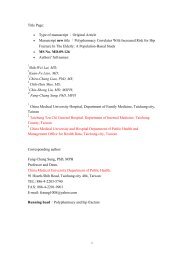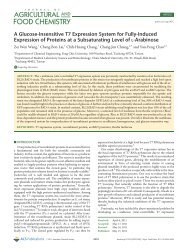Culinary Narratology in Everyday Life: Foodways and Identity ...
Culinary Narratology in Everyday Life: Foodways and Identity ...
Culinary Narratology in Everyday Life: Foodways and Identity ...
You also want an ePaper? Increase the reach of your titles
YUMPU automatically turns print PDFs into web optimized ePapers that Google loves.
Notes<br />
<strong>Cul<strong>in</strong>ary</strong> <strong>Narratology</strong> 29<br />
1 See Grosz, Elizabeth. Volatile bodies: Toward a Corporal Fem<strong>in</strong>ism. Sydney: Allen <strong>and</strong><br />
Unw<strong>in</strong>, 1994; Schill<strong>in</strong>g, Chris. The Body <strong>and</strong> Social Theory. London: Sage, 1993 <strong>and</strong> Bryan<br />
S. Turner (ed). The Body: Social Process <strong>and</strong> Cultural Theory. London: Sage, 1991.<br />
2 Lahiri portrays varied types of first generation women’s attitudes towards the concept of<br />
cultural assimilation. Different from Mrs. Sen <strong>and</strong> Ashima, we also have the k<strong>in</strong>d of mother<br />
<strong>in</strong> “When Mr. Pirzada Came to D<strong>in</strong>e” who prefers her daughter to embrac<strong>in</strong>g American<br />
culture, without a burden of their past history.<br />
3 Lahiri has been criticized for repeat<strong>in</strong>g the stereotypes of the dichotomy, portray<strong>in</strong>g<br />
western womanhood as self-assertive, cold <strong>and</strong> self-centered while the traditional Indian<br />
mothers are warm, motherly <strong>and</strong> thoughtful.<br />
4 Madhuparna Mitra writes that “Mrs. Sen’s” is perhaps “the most poignant” story <strong>in</strong><br />
depict<strong>in</strong>g a female immigrants uprooted from her “comfortable upper-middle-class” home <strong>in</strong><br />
Calcutta <strong>and</strong> re-rooted <strong>in</strong> the new cont<strong>in</strong>ent America (193).<br />
5 As Noelle Brada-Williams <strong>in</strong>dicates, the recurr<strong>in</strong>g themes of Jhumpa Lahiri’s collection of<br />
short stories are the barriers to <strong>and</strong> opportunities for human communications <strong>in</strong> communal,<br />
marital, extra-marital <strong>and</strong> parent-child relationships as well as the dichotomy of care <strong>and</strong><br />
neglect (451).<br />
6 The first time Mrs. Sen decides to get fresh fish on her own is when she takes a bus to the<br />
seaside. However, Mrs. Sen confronts the most direct racist marg<strong>in</strong>alization on her way<br />
home from the fish market. Specifically, she is confronted by an old lady <strong>and</strong> the bus driver<br />
who <strong>in</strong>terrogate Mrs. Sen about the bag she carries. This trip is an unpleasant experience<br />
that deepens Mrs. Sen’s recognition of be<strong>in</strong>g an outsider <strong>in</strong> this society.<br />
7 Mitra’s question<strong>in</strong>g the need to make “assimilative compromises” seems to carry a message<br />
<strong>in</strong>dicat<strong>in</strong>g a teleological <strong>in</strong>tention that all immigrants aspire to a successful assimilation.<br />
8 Critics have described second generation immigrants as “American,” “Anglo-Indian,”<br />
“NRI” for “Non-Resident Indian,” or “ABCD” or American born confused deshi.<br />
9 Lahiri portrays various first generation women’s attitudes towards the concept of cultural<br />
assimilation. Different from Mrs. Sen <strong>and</strong> Ashima, we also have the mother <strong>in</strong> “When Mr.<br />
Pirzada Came to D<strong>in</strong>e” who prefers her daughter to embrace American culture without a<br />
burden of history.









